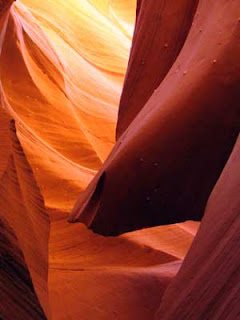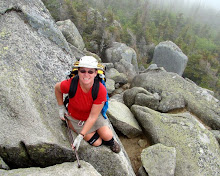My intended destination was Point Imperial, but that plan was cut short when the Park Service closed the road due to very high winds and falling trees. I spent some time at the North Rim viewpoints (carefully hanging on) instead. As my trip to Point Imperial had been cut short I had some time to wander around at Lee's Ferry where I was camped.
The timing of this trip is to attend a Grand Canyon Field Institute Photography workshop. The first hike was into Cathedral Wash for the afternoon where we all took some basic pictures to be critiqued later that evening. Stupid me fell on a rock during this hike, severely curtailing my activities for the remainder of the week. By the time we returned to the Marble Canyon Lodge my foot was bruised, swollen, and extremely painful. I stopped at the gas station to buy ice, then attempted to sleep that night in the car with my foot in a cooler. Yeah, that was comfortable!
The next day's hike was into Buckskin Gulch. I wasn't even sure if I could make it, but I had wanted to do this hike for so long that I just had to try. I used my tripod more as a crutch than a base for the camera, and I didn't get near as far down the canyon as everyone else, but I did get some decent pictures, and learned a lot about lighting techniques, which would be very useful later in the trip.

The next day I was a lot more mobile again, enough so that I led the charge up our next destination, Yellow Mountain. This location was a lot of fun for me: we were out int he sunshine, in terrain that was totally new to me and unique. I loved it. I have to add this to my bucket list of places to hike more and explore. It's an area of eroded cross bedded sandstones with limestone fins that were originally casued by higher rock layers leached down through the sandstone and depositing limestone in the cracks between sandstone blocks. As the sandstone has eroded the harder limestone erodes more slowly and leaves angular fins protruding. The fins are very fragile, requiring careful footing to prevent breakage, but they make for some interesting photographs. The mainly areas light colored rock in this area is very stained by mineral desposits leaching through the existing rock, or from layers that have since eroded away, leaving interesting patches of reds and yellows.
The news about the last day of the photo class was very disappointing to me. I was hoping to visit one of the Coyote Buttes sites, or another dramatic area such as yesterday. When I found out the plan was to visit a stream loction to photograph trees I decided to abandon the remainder of the seminar and go my own way for the next couple of days. It was too late to get my own permit for Coyote Buttes so I decided to visit a couple of nearby areas that I'd wanted to visit.
 Lower Antelope Canyon is a very narrow sinuous slot canyon of sandstone. The Navajo guide led us into the slot by sitting on the edge of a crack int he sandstone and stepping down into the narrow entrance. The canyon is very quite narrow in places and has some fairly steep natural drops which have metal steps to assist getting down into the depths of the canyon. The entire 1/2 mile length is a wonderful twisted experience of wind and water eroded sandstone. Most of the sandstone is smoothly weathered, but the are occasional stone embedded layers that add texture in the wall patterns. The footing is sometime a level sandy layer, but occasionally the slot walls slope all the way down to the floor, requiring careful footing. The Lower Canyon does not seem as popular as the Upper Canyon, but is uniquely different, quieter, and definitely worth a visit at any time of day. In 1997, eleven tourists were drowned during a flash flood in Lower Antelope Canyon. Obviously, the canyon is now closed during any chance of rain or flood.
Lower Antelope Canyon is a very narrow sinuous slot canyon of sandstone. The Navajo guide led us into the slot by sitting on the edge of a crack int he sandstone and stepping down into the narrow entrance. The canyon is very quite narrow in places and has some fairly steep natural drops which have metal steps to assist getting down into the depths of the canyon. The entire 1/2 mile length is a wonderful twisted experience of wind and water eroded sandstone. Most of the sandstone is smoothly weathered, but the are occasional stone embedded layers that add texture in the wall patterns. The footing is sometime a level sandy layer, but occasionally the slot walls slope all the way down to the floor, requiring careful footing. The Lower Canyon does not seem as popular as the Upper Canyon, but is uniquely different, quieter, and definitely worth a visit at any time of day. In 1997, eleven tourists were drowned during a flash flood in Lower Antelope Canyon. Obviously, the canyon is now closed during any chance of rain or flood.  Upper Antelope Canyon is wider at the bottom than the lower canyon, but the very narrow top allows light to shine directly into the canyon only in a few small places, and only when the sun is directly overhead during the middle of the day. This causes shafts or beams of intense light in the very dark canyon. Breezes from above cause sand and dust to filter down through the cracks enhancing the shafts. The canyon is beautiful, has a much more level and wider floor than Lower Antelope canyon, and is very different. It is extremely busy in the canyon during the 2 hours of most intense lighting, and very difficult to get unobstructed photographs, but a beautiful place, and definitely worth a visit.
Upper Antelope Canyon is wider at the bottom than the lower canyon, but the very narrow top allows light to shine directly into the canyon only in a few small places, and only when the sun is directly overhead during the middle of the day. This causes shafts or beams of intense light in the very dark canyon. Breezes from above cause sand and dust to filter down through the cracks enhancing the shafts. The canyon is beautiful, has a much more level and wider floor than Lower Antelope canyon, and is very different. It is extremely busy in the canyon during the 2 hours of most intense lighting, and very difficult to get unobstructed photographs, but a beautiful place, and definitely worth a visit.  Next, I knew there was a place somewhere on the Colorado Rim somewhere in the 15 miles between Glen Canyon Dam and Lees Ferry where there was an overlook of Horseshoe Bend, so I set out to find it, starting at Glen Canyon Dam and working my way downriver. I eventually found a trailhead with a couple of miles hike to the overlook, again well worth it.
Next, I knew there was a place somewhere on the Colorado Rim somewhere in the 15 miles between Glen Canyon Dam and Lees Ferry where there was an overlook of Horseshoe Bend, so I set out to find it, starting at Glen Canyon Dam and working my way downriver. I eventually found a trailhead with a couple of miles hike to the overlook, again well worth it. Next day I visited Walnut Canyon to see the Sinagua Cliff Dwellings. I did not find these neraly as dramatic as the ruins at Sierra Ancha I had seen last year. I also visited the South Rim of the Grand Canyon, but decided to forego the South Rim village as I'd already been there, and stopped at Desert View WatchTower instead. I enjoyed the river views available here that you don't get at the Village, and particuarly being able to look down on the wide beach at Furnace Flats where I'd slept on a rafting trip.
Next day I visited Walnut Canyon to see the Sinagua Cliff Dwellings. I did not find these neraly as dramatic as the ruins at Sierra Ancha I had seen last year. I also visited the South Rim of the Grand Canyon, but decided to forego the South Rim village as I'd already been there, and stopped at Desert View WatchTower instead. I enjoyed the river views available here that you don't get at the Village, and particuarly being able to look down on the wide beach at Furnace Flats where I'd slept on a rafting trip. Last stop was at Coal Mine Canyon. It is like a miniature Bryce Canyon. I would have loved to hike down into the canyon, but the canyon is remote, and there were no other vehicles around at the parking area so it seemed prudent not to venture down alone. I satisfied myself with pictures from the rim.
Last stop was at Coal Mine Canyon. It is like a miniature Bryce Canyon. I would have loved to hike down into the canyon, but the canyon is remote, and there were no other vehicles around at the parking area so it seemed prudent not to venture down alone. I satisfied myself with pictures from the rim.View more photos in my Picasa album
